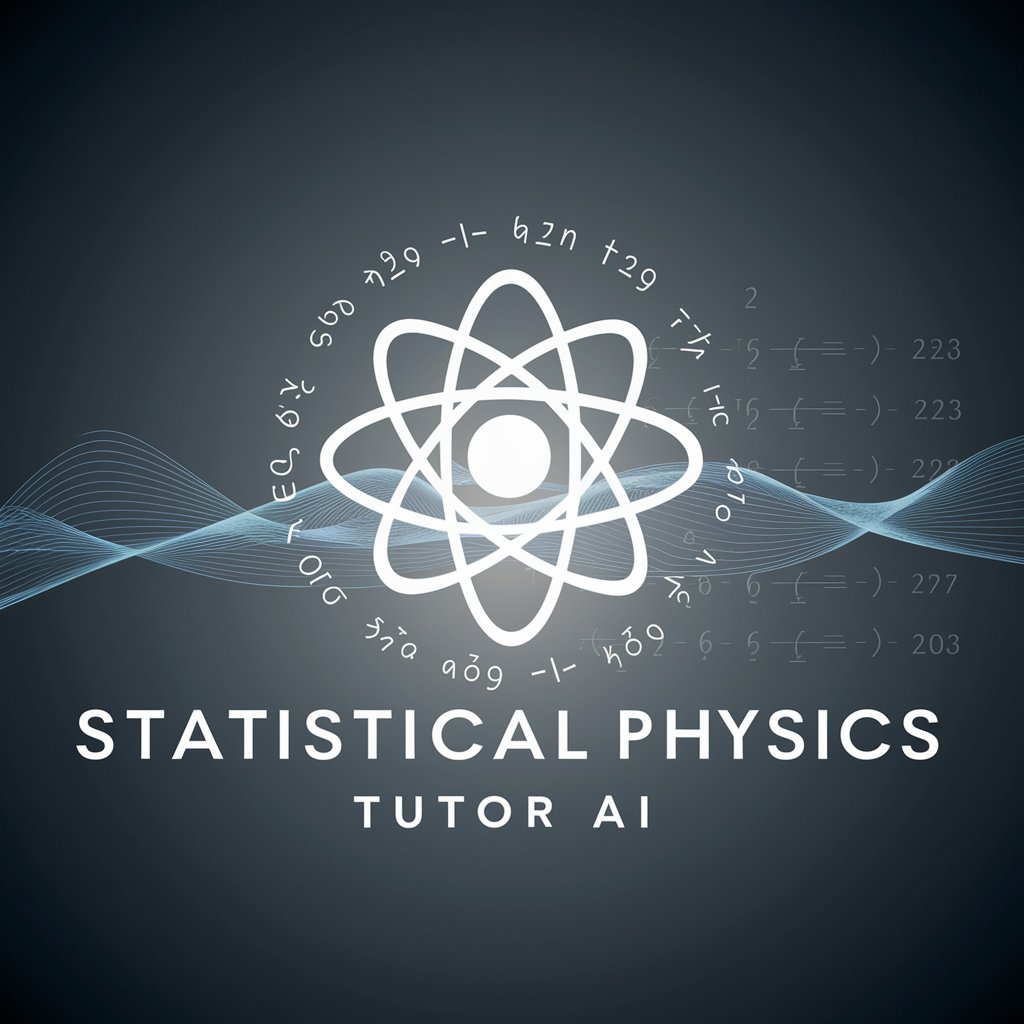
Statistical Physics Tutor - In-depth Physics Insights

Welcome to your Statistical Physics Tutor!
Demystifying physics with AI-powered precision
Can you explain the concept of entropy in statistical physics?
How does the Boltzmann distribution relate to temperature?
What is the significance of Gibbs free energy in chemical reactions?
Could you describe the differences between Fermi and Bose gases?
Get Embed Code
Overview of Statistical Physics Tutor
Statistical Physics Tutor is a specialized AI tool designed to assist students and professionals in the field of statistical physics. It encompasses a broad range of topics including entropy, Boltzmann distribution, Gibbs distribution, ideal gas laws, and phase transformations, among others. Its design purpose is to provide in-depth explanations, solve complex problems, and offer insights into the theoretical and practical aspects of statistical physics. For instance, it can illustrate the concept of entropy through the lens of disorder in a system, using the example of mixing two gases and showing how entropy increases as a result. Powered by ChatGPT-4o。

Core Functions of Statistical Physics Tutor
Problem Solving
Example
Solving a problem involving the calculation of the partition function for a given system, and using this to determine macroscopic properties such as energy and entropy.
Scenario
A student working on their homework encounters a complex problem requiring the calculation of a system's partition function. They use Statistical Physics Tutor to understand the step-by-step approach to solve it, including the integration over phase space.
Conceptual Clarification
Example
Explaining the concept of Gibbs free energy and its significance in predicting the spontaneity of chemical reactions and phase transitions.
Scenario
During a study group session, a question arises about why certain chemical reactions occur spontaneously. Statistical Physics Tutor provides a detailed explanation of Gibbs free energy, using real-world examples like the formation of ice from water below 0°C.
Application to Real-world Situations
Example
Applying the principles of kinetic theory to explain the behavior of gases under different conditions and predicting the outcomes of experimental setups.
Scenario
A researcher is designing an experiment to study the behavior of an ideal gas under compression. They consult Statistical Physics Tutor to understand how kinetic theory can predict the changes in pressure and temperature, aiding in the design of their experiment.
Ideal Users of Statistical Physics Tutor
Upper Division and Graduate Students
Students pursuing advanced degrees in physics or related fields, who need to grasp complex concepts and solve intricate problems in statistical physics. They benefit from detailed explanations and examples that bridge theory and practical applications.
Researchers and Academics
Individuals involved in scientific research or academic teaching who require a deep understanding of statistical physics principles. They use the service to enhance their research, develop new theories, or create comprehensive teaching materials.
Professionals in Applied Physics Fields
Engineers, data scientists, and professionals in fields where statistical physics principles are applied, such as materials science, meteorology, and finance. They benefit from understanding the underlying physics that governs the systems they work with.

How to Use Statistical Physics Tutor
1
Access a comprehensive physics guide without signing up at yeschat.ai, offering a hassle-free introduction to Statistical Physics Tutor.
2
Identify your specific question or topic within statistical physics, such as entropy, thermal radiation, or Gibbs distribution, to focus your inquiry.
3
Utilize the direct query feature to ask your detailed question, ensuring clarity and specificity to receive the most accurate guidance.
4
Explore the examples and explanations provided, taking the time to understand the underlying concepts and calculations.
5
For further clarification or deeper insight, follow up with related questions or request examples of applications in real-world scenarios.
Try other advanced and practical GPTs
Becky
Uncover hidden stories with AI
AI Tutor Math for Grade 4
Empowering young minds with AI-driven math learning.

REST API Sherpa
Empowering API Development with AI

REST Specialist
Elevating API design with AI-powered analysis.

Recipe Wizard
Culinary creativity, AI-powered.

Recipe Simplifier
Simplify Cooking with AI

Ad Explorer
Unlock audience insights with AI.

Ad Strategizer
Empower Your Ads with AI

Ad Skripter
Craft Winning Ads with AI

Creative Scripter
Elevate Your Storytelling with AI-Powered Scriptwriting

Creative Muse
Empowering Design Innovation with AI

Creative AF
Unleash Your Creativity with AI

Detailed Q&A about Statistical Physics Tutor
What is the Boltzmann distribution and how is it applied?
The Boltzmann distribution is a statistical distribution that describes the probability of a system's states based on their energy levels at thermal equilibrium. It's foundational in understanding how particles distribute among available energy states, crucial for explaining phenomena like gas pressure and temperature. It's applied in various contexts, from calculating the distribution of molecular speeds in gases to determining the occupancy of energy levels in semiconductors.
How does entropy relate to the second law of thermodynamics?
Entropy is a measure of disorder or randomness in a system, and the second law of thermodynamics states that the total entropy of an isolated system can never decrease over time. This principle underscores the direction of spontaneous processes, indicating that they will always proceed in a way that increases the overall entropy of the system and its surroundings, which is key to understanding thermal processes and energy distribution.
Can you explain the concept of Gibbs free energy and its significance?
Gibbs free energy is a thermodynamic potential that measures the maximum reversible work that may be performed by a thermodynamic system at constant temperature and pressure. It's significant because it helps predict the spontaneity of processes: if the change in Gibbs free energy is negative, a process can proceed spontaneously. This concept is crucial in chemical reactions, phase transitions, and in determining equilibrium states.
What distinguishes Fermi gases from Bose gases?
Fermi gases are composed of fermions, particles that follow the Pauli exclusion principle and cannot occupy the same quantum state. This leads to phenomena like electron degeneracy pressure in stars. Bose gases, on the other hand, consist of bosons, which can occupy the same quantum state, leading to unique effects like Bose-Einstein condensation. The distinction is fundamental in quantum statistics, affecting the behavior and properties of low-temperature systems.
How is the concept of chemical potential used in statistical physics?
Chemical potential represents the change in a system's energy when the number of particles changes, at constant entropy and volume. It's pivotal in understanding and predicting the direction of chemical reactions, phase equilibria, and the distribution of particles among phases. In statistical physics, it helps describe how particles distribute themselves in different energy levels and across different phases to minimize the system's free energy.





